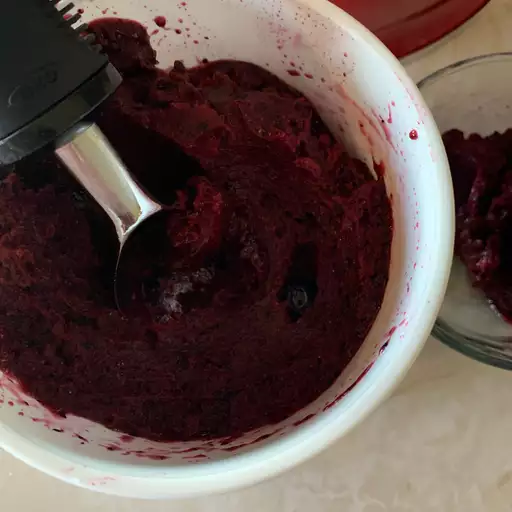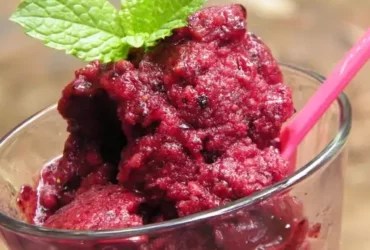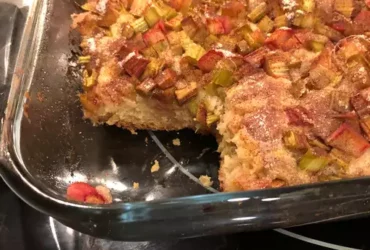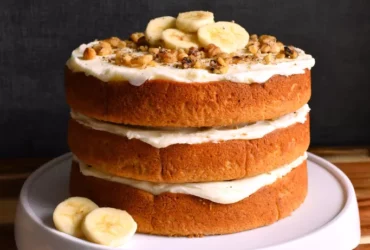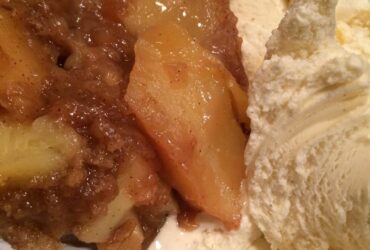Ingredients
Essential Blueberry Compounds
The blueberry sorbet recipe relies on several key ingredients, with blueberries being the primary source of flavor and nutrients. Blueberries are a rich source of essential compounds that contribute to their distinct taste, texture, and health benefits. Some of the most significant essential blueberry compounds include:
Anthocyanins
These powerful antioxidants are responsible for the deep purple color of blueberries. They have potent anti-inflammatory properties and play a crucial role in protecting against cell damage caused by free radicals. Anthocyanins are also known to have neuroprotective effects, potentially reducing the risk of age-related cognitive decline.
Flavonoids
Flavonoids, particularly quercetin, kaempferol, and isorhapontigenin, are present in blueberries and contribute to their antioxidant and anti-inflammatory properties. These compounds have been shown to help protect against cardiovascular disease, cancer, and age-related diseases.
Phenolic acids
Blueberries contain a range of phenolic acids, including ferulic acid, sinapic acid, and p-coumaric acid. These compounds have antioxidant and anti-inflammatory properties, as well as potential anticancer effects.
Tannins
Tannins are also present in blueberries, providing astringent properties that contribute to their distinctive taste and texture. Tannins can help reduce the risk of chronic diseases by limiting bacterial growth and inflammation.
Other essential compounds found in blueberries include vitamins C and K, manganese, and dietary fiber. These nutrients contribute to the overall nutritional value and potential health benefits of the blueberry sorbet recipe.
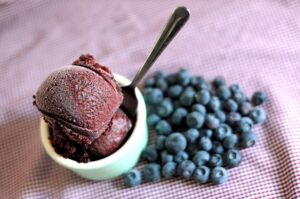
Fresh or frozen blueberries (1 cup)
When it comes to making blueberry sorbet, the quality and freshness of the blueberries used can greatly impact the final result. Fresh or frozen blueberries (1 cup) are essential ingredients in this recipe.
Fresh blueberries are ideal if you have access to them during peak season. They will provide a more intense flavor and texture compared to frozen berries. However, keep in mind that fresh blueberries can be quite perishable and may spoil quickly if not used promptly.
If fresh blueberries aren’t available or if you prefer the convenience of storing your blueberries for later use, frozen blueberries are an excellent alternative. They retain much of their flavor and nutritional value compared to fresh berries and can be easily thawed when needed.
It’s worth noting that the ripeness of the blueberries at the time of freezing can affect the final quality of the sorbet. Frozen blueberries that have been frozen shortly after being picked will generally produce a better-tasting sorbet than those that were frozen later in their life cycle.
In terms of specific characteristics, look for blueberries with a deep purple color and a glossy sheen, which indicate high anthocyanin content and sweetness. Avoid berries with white or light-green spots, as these may be overripe or past their prime.
For the sorbet recipe, 1 cup of fresh or frozen blueberries is sufficient to yield about 2-3 servings. You can adjust the quantity of blueberries based on your desired serving size and the overall flavor profile you’re aiming for in your sorbet.
Granulated sugar (1/2 cup)
Sugar plays a crucial role in this recipe as it helps to balance out the natural tartness of the blueberries and adds sweetness to the sorbet.
For the granulated sugar, we will be using 1/2 cup. This may seem like a lot, but trust us, it’s necessary for achieving that perfect balance of sweet and tangy in our Blueberry Sorbet.
Here are some interesting facts about granulated sugar:
- Sugar is a type of carbohydrate that comes from plants such as sugarcane and sugar beets.
- Granulated sugar, also known as white sugar or table sugar, has been refined to remove any impurities and color.
- It’s composed of sucrose, a disaccharide made up of glucose and fructose molecules.
The importance of using granulated sugar in this Blueberry Sorbet recipe lies in its role as an anti-crystal agent. This means that it helps to prevent the formation of ice crystals during the freezing process, resulting in a smooth and even texture.
Cooking and Pureeing
Blueberry Mixture Preparation
- Cooking and pureeing a blueberry mixture is a crucial step in creating a delicious and refreshing Blueberry Sorbet.
- To begin, you will need to select high-quality fresh or frozen blueberries for this recipe.
Purée Preparation
- Wash the blueberries thoroughly to remove any dirt or debris.
- Rinse the blueberries with cold water and pat them dry with a paper towel to remove excess moisture.
- If using fresh blueberries, you can simply place them in a blender or food processor. If using frozen blueberries, let them thaw first.
Mix the blueberries on high speed for about 2-3 minutes, until they are fully broken down and have reached your desired consistency.
Adding Sugar and Acidic Ingredients
- Add granulated sugar to the blueberry puree, stirring it in until it’s well combined. You can adjust the amount of sugar according to your taste preferences.
- Also, add a squeeze of fresh lemon juice or other acidic ingredients like lime or orange juice. This will help balance out the sweetness and enhance the flavor of the blueberries.
Mix everything together on high speed for another minute, until the sugar has dissolved completely and the flavors are well combined.
Strain and Filter (Optional)
- If you want a smoother sorbet texture, you can strain the mixture through a fine-mesh sieve or cheesecloth to remove any remaining blueberry pulp or seeds.
Discard the solids and transfer the strained mixture back into the blender or food processor.
Purée for a Second Time (Optional)
- If you prefer an even smoother texture, you can blend the mixture for another minute or until it reaches your desired consistency.
Now that your blueberry mixture is prepared, it’s time to churn it into the Blueberry Sorbet Recipe using an ice cream maker or freeze it in a shallow metal pan and then blend it in a food processor once frozen.
Combine blueberries and sugar in a blender or food processor
To make the blueberry sorbet, you will need to combine the blueberries and sugar in a blender or food processor. This is an important step as it helps to break down the fruit and mix it with the sugar.
Here’s how to do it:
- Select fresh or frozen blueberries for this recipe. If using fresh blueberries, rinse them gently in cold water and pat dry with a paper towel before using.
- Add 2 cups of blueberries and 1/4 cup of granulated sugar to the blender or food processor.
- Blend the mixture on high speed until the blueberries are fully broken down and the mixture is smooth. You may need to stop the blender and scrape down the sides a few times to make sure everything gets well mixed.
Once you’ve combined the blueberries and sugar, you can proceed with the rest of the sorbet recipe. This step is crucial in achieving the right consistency and flavor for your sorbet.
Blend until smooth
To achieve a silky-smooth texture, it’s essential to blend the mixture until it reaches the desired consistency. In this case, we’re working towards creating a Blueberry Sorbet that will be perfect for hot summer days.
When pureeing ingredients, there are a few key things to keep in mind:
- Speed control: Make sure your blender or food processor is set to the right speed. If it’s too high, you may end up with a mixture that’s over-blended and loses its texture.
- Temperature: Keep an eye on the temperature of the ingredients as they blend. If they get too warm, it can affect the flavor and texture of the final product.
- Texture monitoring: Stop the blender occasionally to check the consistency of the mixture. You may need to adjust the blending time or add a little more liquid depending on how smooth you want it to be.
In this Blueberry Sorbet recipe, we’ll be using a combination of fresh and frozen blueberries. To puree them effectively, follow these steps:
- Purée the frozen blueberries: Blend the frozen blueberries with a little water until they’re fully broken down.
- Add in the sugar and lemon juice: Mix in the granulated sugar and freshly squeezed lemon juice to add flavor and help bring out the natural sweetness of the blueberries.
- Purée the fresh blueberries: Blend the fresh blueberries until they’re fully incorporated into the mixture, adding a bit more liquid if necessary to achieve the desired consistency.
- Check the texture: Stop the blender occasionally to check the smoothness of the mixture. If it’s still a bit chunky, blend for another minute or two and check again.
- Strain the mixture (optional): If you want an extra-smooth sorbet, you can strain the mixture through a fine-mesh sieve into a clean bowl to remove any seeds or pulp.
Now that your Pureéd Blueberry Mixture is ready, you can pour it into an ice cream maker and churn according to the manufacturer’s instructions. Alternatively, you can freeze it in a shallow metal pan and then blend it again in the food processor once it’s frozen solid.
Whatever method you choose, your Silky-Smooth Blueberry Sorbet is sure to be a hit with friends and family alike!
Sorbet Production
Chilling the Sorbet Base
The process of chilling the sorbet base is an essential step in creating a smooth and refreshing blueberry sorbet. This stage involves cooling the mixture to a temperature that inhibits the growth of microorganisms, thereby ensuring food safety.
To chill the sorbet base, it’s crucial to use a container or freezer-safe vessel that won’t impart any flavors or odors to the mixture. A glass or stainless steel container is ideal for this purpose. Avoid using aluminum or copper containers as they may react with the acidic properties of the blueberries.
Place the chilled sorbet base in the refrigerator at 40°F (4°C) or lower. If you prefer a faster chilling process, you can also use an ice bath or a blast chiller to quickly bring down the temperature. However, be cautious not to introduce any ice crystals into the mixture, as this can affect its texture and consistency.
Once the sorbet base has reached the desired temperature, usually around 32°F (0°C), it’s ready for freezing. It’s essential to note that some ingredients in your sorbet recipe may take longer than others to chill, such as fruit purees or juice. Always prioritize chilling the mixture slowly and gently to prevent the formation of ice crystals.
As a general rule of thumb, if you’re using fresh berries like blueberries, it’s best to chill them immediately after preparation to slow down spoilage. This will also help preserve their flavor and color in your sorbet base.
Some factors that can influence the chilling process include the size of the container, the temperature of the refrigerator or ice bath, and the type of ingredients used in the recipe. Be patient and allow the mixture to chill slowly, taking care not to introduce any contaminants during this critical stage.
Strain mixture through a finemesh sieve into an ice cream maker
To produce sorbet, it’s essential to start with a strain mixture that has been sieved through a fine mesh sieve. This process removes any impurities or solids from the mixture, ensuring a smooth and even consistency in the finished product.
A fine mesh sieve is typically made of metal or nylon, with holes or perforations that are small enough to allow the liquid ingredients to pass through while keeping larger particles behind.
Start by placing the sieve over a large bowl or container. Make sure it’s positioned securely to prevent any spills during the sifting process.
Next, carefully pour the strain mixture from the previous step into the fine mesh sieve. You may need to work in batches depending on the amount of mixture and the size of your sieve.
Gently lift and tilt the sieve to allow the liquid ingredients to pass through while keeping any solids behind. Continue until all of the mixture has been filtered and you’re left with a smooth, even consistency.
Once you’ve strained the mixture through the fine mesh sieve, it’s ready to be placed in an ice cream maker. If using an older-style ice cream maker with a manual turning handle, proceed to the next step by pouring the chilled mixture into the machine and turning the handle until it’s fully churned.
For modern electric ice cream makers or automatic machines with a built-in churning mechanism, simply pour the chilled mixture directly into the machine and let it do the work for you. In most cases, the machine will alert you once the sorbet has reached its desired consistency and is ready to be removed.
Always follow the specific manufacturer’s instructions for your particular ice cream maker model when operating it, as some variations may differ slightly from the general process outlined above.
After removing the sorbet from the machine, transfer it to a freezer-safe container with an airtight lid and place it back in the freezer. This will help maintain the texture and prevent the formation of ice crystals on the surface.
Follow manufacturer’s instructions for churning and freezing
Sorbet production involves a multi-step process that requires careful attention to detail, quality ingredients, and adherence to manufacturer’s instructions for churning and freezing.
Step 1: Preparation
Begin by preparing the blueberries. Wash and hull them, then pat dry with a paper towel to remove excess moisture.
- Measure out the required amount of sugar (typically 2-3 times the weight of the blueberries) and place it in a separate container for later use.
Step 2: Mixing the Ingredients
Mix the blueberries with a small amount of lemon juice or water to enhance flavor and prevent browning, then combine them with the sugar in a blender or food processor.
- Add any additional ingredients, such as water or simple syrup (a mixture of equal parts sugar and water dissolved) if desired.
Step 3: Puréeing the Mixture
Purée the mixture in a blender or food processor until smooth and free of lumps.
- Strain the purée through a fine-mesh sieve to remove any remaining solids and achieve a smooth consistency.
Step 4: Churning the Sorbet
Churn the sorbet mixture in an ice cream maker according to the manufacturer’s instructions, typically around 20-30 minutes.
- Add a small amount of water or simple syrup if needed to thin out the mixture and achieve the desired consistency.
Step 5: Freezing the Sorbet
Transfer the churned sorbet to an airtight container and place it in the freezer to harden for at least 2 hours or overnight.
- Once set, scoop and serve immediately, garnished with additional blueberries if desired.
- Best Datanyze Alternatives for 2025 - April 24, 2025
- Best Hunter.io Alternatives for 2025 - April 22, 2025
- Best Lead411 Alternatives for 2025 - April 22, 2025

